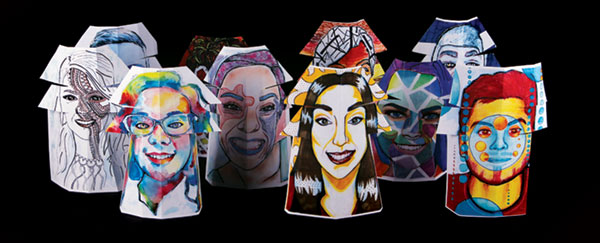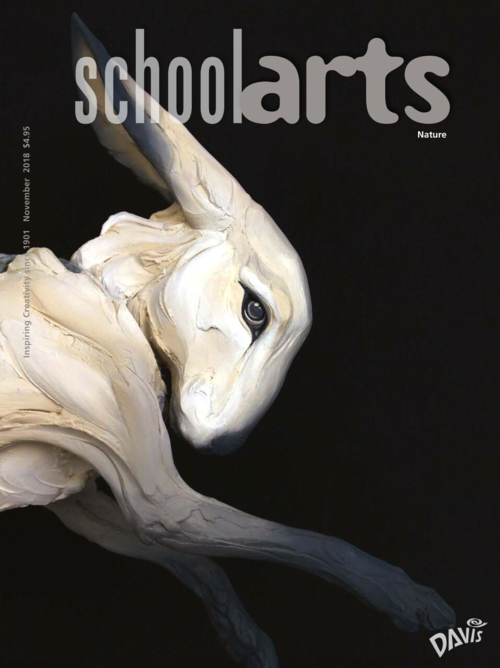
The idea of keeping a gratitude journal comes from a book called Simple Abundance by Sarah Ban Breathnach, in which the author explores the idea that acknowledging gratitude will unlock the fullness of life while nurturing creativity. The experience of writing a gratitude journal was a life-changing one for me, and I feel my life has been enriched with a daily feeling of deep thankfulness.
The Project at a Glance
Students use journals or sketchbooks to create a list of positive qualities they are personally thankful for and appreciative of in their lives.
Next, they create a self-portrait using a photocopied color image of themselves as a jumping-off point. The end result is a mixed-media freestanding paper sculpture that has a color portrait on one side and a written document using text from their journals on the other.
Starting with a Gratitude Journal
Instruct students to keep a personal journal focused on the things for which they are most thankful. During the course of a week or more, ask students to add a daily entry. Explain that they will create a gratitude list that will be significant to the success of this project. It should not take any more than a few minutes each day. Students should aim to have thirty to fifty items on their gratitude list.
Part of this writing should happen during a weekend because varied environments will trigger different thoughts. Instruct students to be creative with their sentence structure and avoid making simple lists. The goal is to document personal appreciation, gratitude, and thanksgiving.
When the writing phase is complete, have students read through their lists. What are the things that stand out the most? These words, sentences, and phrases can be highlighted.

The Art-Making Process
Ask students to each think of something that makes them really happy and then take a full-face photo with that expression. Print the photos on 8 x 10" (20 x 25 cm) heavy quality paper. Next, have students mount their image on a piece of cardboard to provide stability during drawing and painting. Use painter’s tape so it can easily be removed later.
Students next apply white acrylic paint to the background and the majority of the face. This eliminates 85 percent of the color in the over-all image, leaving a linear drawing. Allow the drawing to dry.
Photocopy the resulting images so students can experiment with color and design as they creatively develop their compositions with the media of their choice. Instruct students to personalize their images by repetition of colors, shapes, and patterns to create visual unity.
Remind students that the eyes (the “windows to the soul”) should be colorful and a real focal point for both the student and the viewer.
When the images are complete, ask students to fill in the backs of their portraits with the sentences, words, and phrases from their journals. Ask them to highlight the most significant keywords and phrases. This shows the connection of the artist’s portrait to the writing. It also describes what we look like on the outside with what we sometimes don’t share on the inside.
When the portraits are finished, have students use a ruler and pencil to mark a 2" band across the eyes (which will also leave 2" between the eyes). Show students how to cut these lines in from both sides and then score, fold, and glue to create a freestanding sculpture
in which both sides are visible.
Student Self-Evaluation
- Does your list of what you are thankful for reflect a wide variety of aspects in your life?
- Which was harder: developing the image of yourself or creating the list of reasons you are thankful? Why?
- What have you learned about yourself through this experience?
- Will you continue to think about all you have and have been given?
Conclusion
Now more than ever, we need to encourage introspection in thinking as well as a positive attitude towards mental health with the adolescents we teach. We should encourage greater awareness of the good things in life. This can be accomplished with art projects that have a thoughtful, creative, and reflective structure. The projects we develop can create new roadways of reflection, introspection, and hopefully, in this case, a life filled with thanksgiving.
Ken Vieth is the author of The Visual Experience, From Ordinary to Extraordinary: Art and Design Problem Solving, and Engaging the Adolescent Mind Through Visual Problem Solving, all published by Davis Publications. He is also a frequent contributor to SchoolArts. kcvieth@gmail.com
Robin Rudy is an art teacher at Hunterdon Central Regional High School in Flemington, New Jersey. rrudy@hcrhs.org
NATIONAL STANDARD
Connecting: Relating artistic ideas and work with personal meaning and external context.
WEB LINK
www.greatergood.berkeley.edu/article/item/ tips_for_keeping_a_gratitude_journal
View this article in the digital edition.



